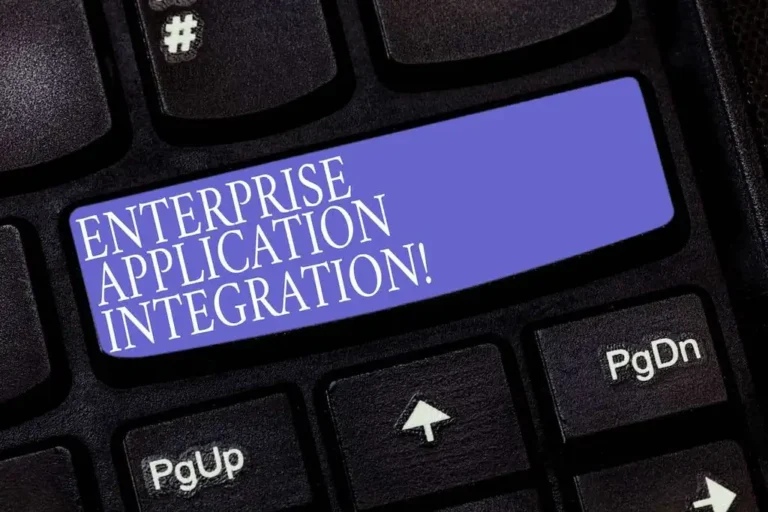What is Enterprise Application Integration and Why It Matters

Operating applications independently, without integration, can create data silos that hinder employees from accessing information promptly. This results in worsened performance and convoluted processes impacting overall productivity. Enterprise application integration (EAI) is crucial to building a single system that facilitates data sharing. Such solutions are extremely intuitive. Their deployment is possible without significant database configurations. In this guide, we will analyze the significance of EAI and consider the main reasons to build such a framework.
What is Enterprise Application Integration?
EAI is a process of building an ecosystem comprising apps and databases to streamline information transmission. Such solutions foster automation and expedite project completion. Organizations utilize such platforms to follow a consistent approach when embracing information usage practices. EAI ensures synchronization across the systems, as updates in one app are implemented across the network instantly.
Enterprise application integration services function like middleware linking different programs in a single framework. Leveraging EAI does not require advanced programming skills, as engineers do not need to conduct pivotal upgrades. Such tools rely on the following technologies:
- Enterprise service bus (ESB)
- APIs
- Service oriented architecture (SOA)
- MOM-based communication
Advanced EAI systems connect a variety of internally hosted apps and cloud services. They are invaluable for large teams that can benefit from making their workflows less convoluted. Using the integration platform as a service (iPaaS) model, firms do not need to manage software that connects different applications.
EAI platforms are invaluable for enterprise resource planning, as they integrate with CRM and HCM systems. Engineers can add and remove apps, update existing services, and perform other tasks without significant effort.

We are confident that we have what it takes to help you get your platform from the idea throughout design and development phases, all the way to successful deployment in a production environment!
Why Use EAI?
Every company that wants to automate business processes faces difficulties with linking different apps and ensuring that information will be accessible by employees. Preventing data silos from forming requires using dedicated tools that remove inconsistencies and duplicates. Engineers may be required to fix issues to streamline routine processes.
EAI tools expedite workflow automations and guarantee developers will be able to eradicate mistakes and access information. Utilizing such solutions is crucial for companies interested in expanding the scope of operations and achieving consistent growth. Such systems have multiple benefits:
- Reduced risk of silos: Heightening information accessibility across the system, such products enable users to view it from a centralized dashboard.
- High data quality: Enterprise application integration eliminates mistakes and makes it easier to achieve consistency. Team members can work together on projects and leverage analytics tools to make result-yielding decisions.
- Streamlined processes: Integrating the services utilized by a company, EAI platforms make internal processes less convoluted and enable teams to finalize projects quickly.
- Enhanced satisfaction: As staff members see the updated customer info, they can serve clients and manage resources efficiently. Anyone can use self-service portals to retrieve the information they need.
- Lower expenses: Professionals spend less valuable resources when working on projects, which allows firms to allocate more capital to research and development. Updates are synchronized automatically across all the apps, eliminating the need to perform manual operations.
Utilizing architecture based on microservices, EAI systems comprise many applications that can be deployed independently.

Challenges With Utilizing EAI Platforms
Companies of all sizes may face issues when trying to implement EAI solutions. Making them an integral part of established workflows may be arduous without removing barriers hindering the adoption. A firm may face multiple issues:
- Advanced technologies: Integrating complex systems requires a high level of expertise to ensure their stable functioning.
- Compatibility: EAI platforms should work together with legacy systems. However, many modern apps do not support older technologies.
- Scalability: Even if apps work together without any issues, a company may still face problems trying to expand operations. Whether it uses public cloud services or on-premise systems, it should monitor the performance of EAI platforms to accommodate increased workload.
- Security issues: Service providers building solutions must adhere to regulations and add extra layers safeguarding valuable info.
As the complexity of such platforms increases, a firm must invest more in advanced security options and focus on choosing the most suitable architecture.
EAI Models
As there is no golden standard when it comes to EAI, firms utilize multiple types of communication. The evolution of EAI resulted in faster data transfer and led to the development of advanced systems based on different technologies.
- Point to point integration (P2P integration): The earliest EAI systems were utilizing scripts to transfer data between apps. The limitation of this approach lies in the fact that it is hardly suitable for connecting many digital products.
- Hub and spoke integration: A central hub links apps, saves data in supported formats, and distributes it. As there is no need to establish individual dependencies, this model is more suitable for complex systems. However, it still requires continuing maintenance, as engineers must route data manually.
- Bus integration (ESB): This recent model has been utilized by enterprises that want to automate processes fully. It stands out for its governance standards controlling data transfer.
In addition, companies use different middleware to connect UI and OS. The tools facilitate transferring information and contribute to synchronization. Organizations also rely on the power of cloud computing and use architecture based on microservices to run apps remotely and route info effectively, deploying APIs.
Main Purposes of EAI
New data governance practices were designed to connect separate apps to streamline transmission and enhance information quality. Firms utilize such platforms to meet the following objectives:
- Improve integration: EAI services foster communication and re-format updates, making them available across many apps. Utilizing secure storage allows for accessing information from anywhere.
- Workflow optimization: EAI products are fitted with advanced tools that enable staff members to maintain records, update data, and perform other operations with few mistakes.
- Interface integration: Companies deploy EAI to access databases using a single interface.
Firms deploy hybrid cloud solutions to host new apps on the public cloud while keeping legacy systems on premises. This model is better than traditional middleware networks, as it facilitates accessing containerized apps. When selecting an EAI design, firms may decide to combine different models to safeguard data, leverage the newest technologies, and improve internal information exchange.
Companies interested in enhanced transaction security deploy the ESB model to handle errors using lightweight solutions tailored to their needs. Such tools are easier to integrate as they do not require advanced coding skills. They are used for multiple purposes:
- Save data in readable formats
- Ensure conversions between protocols
- Streamline the routing process
- Facilitate performance monitoring
- Heighten security
The ultimate choice between EAI models depends on a company’s preferences, including the scale of its operations. EAI is an innovative approach that streamlines data exchange and ensures the functioning of many apps within a single infrastructure.
Choosing the most suitable EAI architecture and integrating such solutions with legacy tools may be impossible without hiring experts with relevant skills. Outsourcing this task to trusted service providers enables firms to minimize expenses.
The Global Cloud Team includes seasoned developers who specialize in building advanced digital products and provide continuing maintenance services. Contact our professionals now and learn how to leverage enterprise application integration to scale your business.
Top Articles
Container vs VM (Virtual Machines): How Do They Differ?
I am here to help you!
Explore the possibility to hire a dedicated R&D team that helps your company to scale product development.






